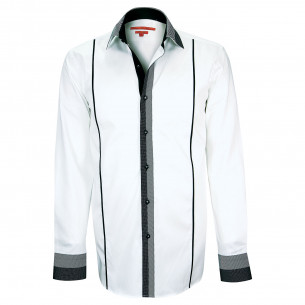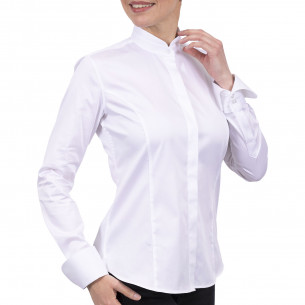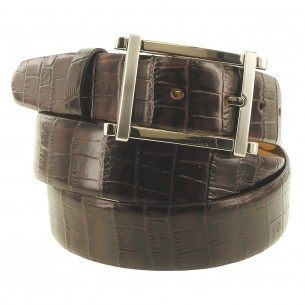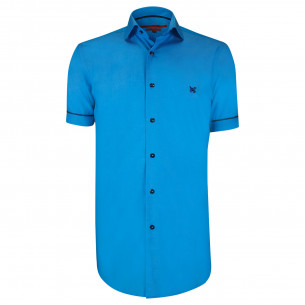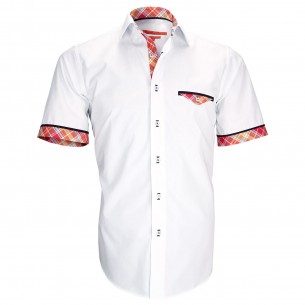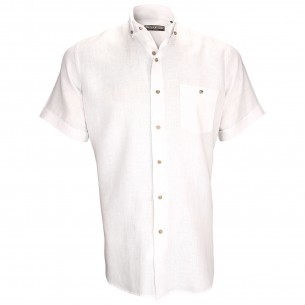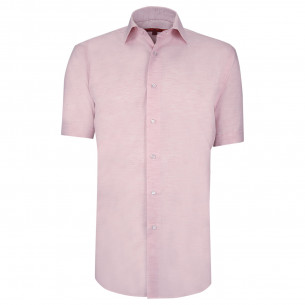What is a Linen's Shirt
Historical overview of the use of linen as textile
There are about 100 varieties of linens united under the botanical name of Linum usitatissimum. Of all these varieties, two are particularly cultured. One of these varieties has short stems, 50 to 70 cm and produces rather large seeds from which oil is extracted: it is linseed. The other variety is recognizable by its long stems of 80 to 120 cm and produces smaller seeds: it is the flax textile, that which is used to make the linen cloth. Linen fiber offers a lot of qualities. It is characterized by its length, strength, elasticity, hydrophilicity and finesse. As much quality found in clothing that is fashioned in linen.
Flax is a herbaceous plant that has been cultivated throughout Eurasia for several thousand years, as we have just seen, to harvest its seeds - from which a food oil is extracted - than to extract a textile fiber. This flax fiber is also, until today, the oldest engineered fiber that was discovered by archaeologists who, in 2009, found 30,000 years old residues in a Georgian cave!
Other historical sources tell us that the Assyrians and the Babylonians dressed in linen tunics. Just like the Egyptians whose priests were dressed only in linen cloth, fabrics that were also used by all the rest of the population, all ranks and all classes. This people attributed to the goddess Isis the discovery of flax.
With regard to Greco-Roman antiquity, there are many accounts of a similar use of linen for clothing purposes. Herodotus and Thucydides mention it for Greece, and tell us that linen cloths were of great use, that the Greeks were clothed in linen, and that flax was cultivated and worked in large quantities in that country. As for ancient Rome, we can refer to the testimony of Pliny the Elder, who tells us that the Romans wore linen for underclothes, that is to say in tunics. But the textile fibers extracted from linen were also intended for other uses - making sails, ropes, carpets etc. - like all the other filamentous materials which, in various countries, filled the same destinations: hemp, aloe pite, yucca, hops, or banana. As for the Hebrew people, he had affected linen with all priestly ornaments and his use was therefore at once symbolic, prestigious and religious.
The use of flax, it will be understood, does not date from yesterday, but goes back well to the origins of the Indo-European civilizations.
Flax is already used in the Middle Ages in northern Europe, even though the weaving of silk is almost unknown and the weaving of wool is only in its infancy. But linen is very rare and therefore very expensive, which hinders widespread use.
In the fourteenth century, linen was used mainly to make table linen that was used in the courts of different European monarchies. One can still admire in many museums dedicated to textile splendid linen table services made in Holland and the Netherlands, in the period from the fourteenth to the seventeenth century. Finally, at the end of the 17th century, the use of flax became commonplace and it was used to make underwear whose use spread throughout Europe.
Under the reign of Louis XIV, and thanks to the wise and prudent administration of Minister Colbert, factories of damask, engraved, and armored, were established simultaneously in several provinces, including Picardy, Artois, Lorraine and Flanders. It made great use of the textile fiber extracted from linen.
How is linen fabric made?
Originally, the name of web is a generic expression, which applies in the vulgar language to fabrics of various matters. Thus we speak of cotton canvas, but in this case, the word "canvases" is followed by the particular name of the material that makes up the fabric. When, on the other hand, the word cloth was used in isolation, it applied only to hemp or linen fabrics, and mainly to plain fabrics, that is to say to those which are neither satin nor worked, not damasked. That being said, let's go back to our sheep and the way we make linen that is used to design both clothes and linens.
Flax sows in the spring. It takes 100 days to lift and reaches a height of about 1.20m. It is particularly sensitive to climate and soil conditions and needs moisture and softness. Flowering takes place in mid-June when the fibers have reached their maximum size. Harvesting will take place about five weeks after flowering when the stem of yellowed flax is at the end of July. The flax is removed from the ground and not mown, and the flax is left to lie on the ground. This is when the first stage of transformation, retting, will take place.
retting
Retting is the first natural phase of transformation of the plant into fibers. It's about letting the rain and sun act to help dissociate the fibrous parts. The action of microorganisms and bacteria present on the soil also helps retting by eliminating the pectose that binds the textile fibers to the woody part of the plant. This stage lasts from two to three weeks depending on the weather conditions.
At the end of the retting, when the straws are sufficiently dry, they are pressed in bales and stored in the shelter before going to scutching.
scutching
Scutching is the second stage of transformation of the plant into fibers. It is a mechanical action that separates the wood from the fiber by grinding. The flax fibers contained in the stems must be able to be extracted without being entangled. On the contrary, they must be constantly adjusted, equalized, ordered, smoothed. The fibers obtained fall into two categories: the long fiber that will be used in the manufacture of linen and the short fiber, also called tow, which will be used in all other areas, mainly to achieve sealing. At the end of the dye, the long fibers are sorted into homogeneous batches.
The following steps are particularly dedicated to the textile sector, starting with combing. This is a first spinning operation during which the fiber is parallelized, calibrated and stretched in the form of ribbons ready to be spun in the next step, the spinning itself. Spinning is broken down into different stages that transform the fibers into yarn. From this thread, we will finally be able to proceed to weaving, that is to say to the manufacture of the fabric or the linen fabric by making cross warp and weft thread. The last stage of this odyssey that goes from the plant to the textile is called ennoblement. This time it is whitening, tinting, printing or finishing the fabric.
It should be noted that it is to a Frenchman, the mechanical engineer Philippe de Girard, that we must have invented the mechanical spinning of flax. He will file a first patent for his linen spinning machine on July 18, 1810.
Advantages and disadvantages of linen
The benefits offered by flax are numerous.
First from an ecological point of view. Flax is a natural fiber from a plant whose transformation into yarn requires the use of natural and non-chemical processes. In addition, flax is mainly grown and processed in Western European countries such as France, Belgium and the Netherlands, these three countries alone accounting for more than 80% of world production. France is the leading European and global tonnage producer with high productivity. Its carbon footprint is therefore low. Using linen in garment making therefore means defending territorial know-how where local resources and skilled jobs are used.
Secondly from a user comfort point of view. The linen fabric is soft and light. It is a fabric that breathes, has a high absorption capacity and therefore dries very quickly. It is therefore particularly suitable for use in warm climatic conditions and will be ideal for people who tend to sweat.
Thirdly, linen is at once elegant and robust. Flax fiber is longer than cotton fiber. She is also more robust.
As for the principal inconvenience of flax, not to say unique, it holds in one word: it creases easily. But, on the one hand, it is enough to iron it for the smoothing and especially, on the other hand, it is not even necessary to do it since one speaks for the linen and for the linen only, a noble wrinkling, since it is agreed and proper to wear it like this!
Trendy and fashion
For centuries, linen has been used extensively in Europe in the clothing industry. This quasi-hegemony will be shaken in the late nineteenth century, when cotton cloth will take an increasingly important place in the clothing industry. The decline continues during the twentieth century with the arrival on the market of synthetic textiles. So much so that linen is almost used only in the design of linen. But the 1960s and the wind of change that will blow soon put flax and other natural textiles such as hemp cloth, up to date. Healthier, more natural, youth seizes these materials as an emblem. The great couturiers follow who like to work flax, like Jean-Charles de Castelbajac or Paco Rabanne. Since that day, linen has never disappeared from our wardrobes and locker rooms. Today he is back in force, modernized by new treatments, exuded by shimmering colors, ennobled by associations of subjects.
The linen shirt
Linen is often used in the clothing industry. And especially in the making of shirts. The linen shirt is, since the 1960s, present in many male wardrobes. And this is not a coincidence. Indeed, the linen shirt is an alternative of choice for who wants to dress with relaxation, but not without elegance. Indeed, if the linen shirt is less formal than the traditional cotton shirt, it remains very distinguished. She embodies a particular style, a way of conceiving elegance with something informal and summery. Summer because the linen shirt is light, because it is worn on canvas pants as on a Bermuda shorts, it is often surmounted by a soft collar that is so open and obviously without a tie , and that it can also be worn rolled up sleeves without losing of its elegance.
If you want to adopt a casual look, ChemiseWeb.com offers you to choose from a wide range of linen shirts available in straight cut or fitted cut, but also short-sleeved linen shirts and large size linen shirt . All our linen shirts are fashioned in a high-end fabric that has been stonewashed. This treatment makes it possible to soften the linen fabric, to give it a soft touch and to give it a slightly patinated appearance.
New shirt short sleeves collection
